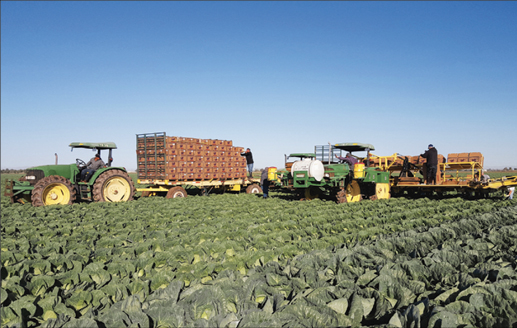After a couple of years of pandemic-induced turmoil, the 2021-22 growing season is looking almost normal in Imperial County, California’s renowned winter salad bowl.
“It’s looking good,” said Alex Jack, who grows broccoli, cauliflower and lettuce and romaine hearts in Brawley. “Normally, we have the ups and downs, and we just really haven’t had the downs. So far, (I’m) pretty happy with the way the season’s been going.”
The Imperial Valley, including Imperial County and part of Riverside County, produces an estimated two-thirds of vegetables consumed in the U.S. during winter months. Holtville farmer Jack Vessey said mild winter conditions back east can help drive market demand.
“They’re starting to see a little bit of weather now, but the consumers are out buying lettuce and eating salads,” said Vessey, who farms cabbage, spinach, leaf lettuce, romaine, cauliflower and broccoli.
One minor issue for Imperial County growers has been lettuce ice, which can form on crops when temperatures dip below freezing. Harvest crews have to hold off until the ice melts to avoid crop damage.
Vessey said his harvest crews usually go to work between 6 and 7 a.m.
“There were a few days when it was between 8 and 9,” Vessey said. “We were able to catch up—it didn’t really affect us too bad. Just kind of worked a little bit later in the day, but it didn’t get to a point where it really curtailed harvest.”
Vessey said the chilly nights have affected other vegetable crops as well.
“With the cold, cauliflower really slows down,” as does cabbage, Vessey said. “We’ve had to back off a little bit in regards to our harvest projections and cut some orders back, but slowly but surely it’s coming back to normal numbers.”
Vessey said demand will determine how the season ends up.
“As long as demand’s there and we’re harvesting everything, and not leaving stuff, leaving product in the field and walking by product, we will be OK,” Vessey said. “We haven’t seen too many walk-bys.” A walk-by is when a field goes unharvested due to lack of demand.
Two years ago, the onset of the COVID-19 pandemic caused food-service markets to vanish almost overnight. So far this year, the news is better.
“We’ve seen quite a rebound on the food-service side,” Vessey said. “I think it’s somewhat back to normal.”
Over the past couple of years, “supply and demand was going up and down quite a bit, depending on if California were opening or closing restaurants and things like that,” Jack said. “There was a big oversupply for quite some time, and the Salinas shippers were getting beat up pretty good.”
That led to cutting acreage, he added, although that had a benefit. “We seem to be having good, steady pricing, because the acreages seem to be down on all commodities,” Jack said.
In 2020 – the most recent year with figures available—Imperial County farmers grew 104,235 acres of vegetables, according to the agricultural commissioner’s crop report. While that’s down from 120,415 acres in 2019, the 2020 crop was worth considerably more – nearly $896 million, up from $799.4 million in 2019.
Iceberg lettuce from the Imperial Valley and the Coachella Valley to the north was fetching $10.45 to $12.45 per carton as of Jan. 12, according to the U.S. Department of Agriculture Agricultural Marketing Service. A year earlier, the same carton sold for $9.50 to $13.45, though demand was lighter, according to USDA data.
Romaine prices also were up – to $16.45 to $20.45 per carton – for Imperial and Coachella products, according to USDA. In mid-January 2021, a romaine carton went for $9.50 to $12.95.
Jack said he prepared for 2021-2022 by moving much of his acreage away from furrow and sprinkler irrigation, with an eye toward conserving water and fertilizer.
“We installed over 1,000 acres of buried drip pipelines,” Jack said. “We’re using drip irrigation for a lot of our crops this year, and we’re having fantastic results. Our yields are through the roof. Our quality is excellent.”
Jack said farming has been more expensive lately largely due to rising fuel and electricity prices, as well as California’s minimum wage, which on Jan. 1 went up to $15 per hour for larger employers of 26 or more, and $14 for smaller companies.
“There’s a lot of factors that have raised our costs,” Jack said. “On the processing side, they’ve gone back to their customers and got a price increase, just to offset, to pay our higher costs that were unforeseen when we made our budgets.”
Meanhile, the pandemic has worsened existing labor shortages.
“We’re like everyone else – it’s hard to get workers,” Jack said. “Normal jobs like water trucks and things like that – t’s tough to find people that want to work right now. I think that’s part of the reason why the prices on commodities are to the strong side, is because we’re not getting full harvest crews out there to harvest the crops.”
The growing end of the season also suffered, he said.
“We’re struggling all season long to have a full crew out there to get everything planted,” Jack said. “We’ve worked our tails off to get it done, but it’s been extra work this year.”
How will the rest of 2022 play out? “Who knows?” Jack said. He said “farmers are always optimistic,” but challenges may loom.
“Based on acreage being down, and it seems like this growing season is cooler than what we’ve had in the last few years, I expect supply to be a little bit tight for the rest of the season,” he said.
Vessey observed that “it seems like we’re covering every acre and getting all the heads or pounds harvested that need to be.”
“You plant for a certain number,” Vessey said. “You plant for a demand number to hit that you’re guessing on. So far, so good. We’ve been able to hit those numbers.”
– Kevin Hecteman, California Farm Bureau

















